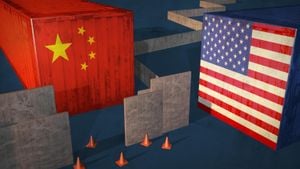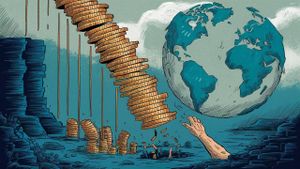Donald Trump's trade policies have been at the forefront of economic discussions since his ascent to the presidency. From tariffs and trade wars to potentially reshaping America's trade relationships, the stakes are undeniably high. Recent analyses have shown just how precarious the situation is, with fears of recession and market fluctuations dominating the conversation.
According to BCA Research, the risk of recession has jumped dramatically to around 75%, fueled largely by Trump's proposed tariffs, which could strike at the heart of household incomes and corporate investments. These potential tariffs include universal tariffs ranging from 10% to 20% on imported goods and even more significant tariffs—up to 60%—on products from China. If implemented, experts warn, these tariffs may not only depress corporate investment but also lower real disposable income for American families by thousands of dollars.
For many on Wall Street, the expectation of such drastic changes is alarming. Peter Berezin, BCA's chief global strategist, highlighted the dangers of Trump's tariff plans, emphasizing how these could lead to reduced disposable income for median households—estimations suggest impacts could vary widely, from $1,900 to as much as $7,600. This kind of economic turbulence creates what Berezin described as a "double whammy" for consumers.
Despite some analysts believing Trump’s threats might simply be tactics for leverage during trade negotiations, there's widespread concern about the realistic chances of such tariffs materializing. Berezin stated, "Whether Trump carries out these threats is open for debate," but suggested there’s reason for skepticism, noting previous underestimations by market participants.
The impact of Trump's policies isn't merely theoretical. Markets seem volatile already, reflecting investor jitters about potential disruptions caused by these shifting trade dynamics. Following Trump's latest electoral victory, markets experienced notable moves—stocks such as bank shares surged, mirroring patterns seen after his first win. But with high valuations and pressure from inflation, many investors are surely wary of the sustainability of any immediate gains.
Historically, Trump's earlier administration saw businesses react strongly against the potential for tariffs, leading to pricing adjustments and strategic shifts. Now, with the looming threat of new tariffs, businesses nationwide seem to be preparing for cost increases, highlighting the direct correlation between his trade policies and market behaviors.
It's also important to note how these risks aren't confined to the U.S. On the global stage, Trump's proposals have drawn ire from major trading partners, with countries like China already hitting back at any potential tariff escalations. Given the growing sentiment against U.S. protectionism, retaliatory measures could not only affect specific sectors but ripple through global economies, reigniting trade tensions reminiscent of previous trade wars.
Adding to the mix are the economic fundamentals. Trump's trade policies come at a time when the U.S. is grappling with elevated interest rates and inflationary pressures. The series of interest-rate hikes over the past few years has created what Berezin calls "restrictive levels" for economic growth, making the backdrop for any proposed tax cuts murky at best. Noticeably, the housing market has shown signs of strain under these pressures, reflecting broader concerns about consumer spending and investment.
Internationally, some experts warn about the potential for instability if Trump's expansive trade policies lead to serious economic backlash. Paul Krugman, opining on the ramifications of potential trade wars, pointed to how Trump's aggressive tariff policies might not only strain relationships with allies but could end up backfiring on American consumers who would face higher prices without the assurance of improved domestic manufacturing. He raised alarms about the impact of tariffs not just hurting consumers but also pushing necessary allies away from cooperative economic solutions.
Despite the optimism stemming from projected tax cuts and deregulation during Trump's first term, the diversification of the economy presents challenges now. The speculative nature of investments linked to tokens, cryptocurrencies, and the overall stock market leaves many questioning the long-term viability of the so-called "Trump trade". The euphoria seen six years ago doesn’t appear to be transferable, raising significant concerns about whether the lifting and positioning of capital will persist under renewed trade war threats.
Looking at the bigger picture, many analysts are concerned about not just the economic fallout but also how Trump’s presidency could shape long-term U.S. trade relationships. With Chinese economic growth hitting saturation points, any aggressive moves to diminish imports might simply force economies to adapt rather than collapse or retreat entirely. This interplay suggests the specter of long-term instability if policies take the wrong turn.
The unpredictability of Trump's plans is compounded by potential frictions brewing within Congress, where bipartisan support is volatile and uncertain. Trump's approach may paint him as bulldozing through typical legislative processes, which could only add to investor fear as negotiations between various political factions heat up. With interest rates already having risen sharply, any additional economic turbulence could quickly dampen market enthusiasm and push growth forecasts even lower.
Over the next few months—leading up to the next potential Presidential elections—analysts will likely keep close tabs on both global trade dynamics and national economic indicators. Shifts on both fronts will shape not just the stock market but potentially the livelihoods of countless Americans depending on stable employment and sound economic policy. Keeping fingers crossed might be the mantra for many investors as they watch the developments play out.
Conclusion: Embracing trade policy will require sharp balance, patience, and foresight to navigate any stumbling blocks effectively. Just how willing Trump and his administration are to engage seriously with the nuances of trade reorientation remains to be seen. If history has taught markets anything, it's always wise to prepare for the unexpected.



